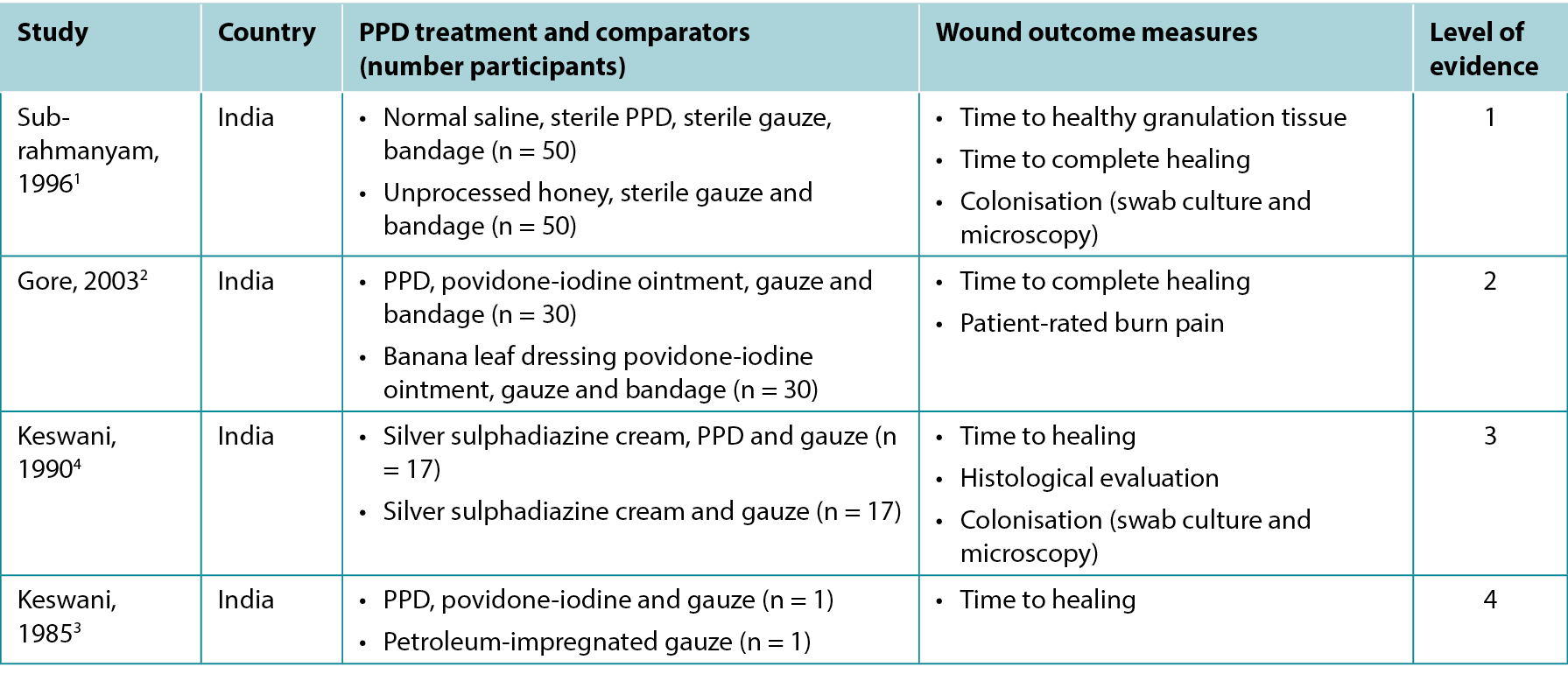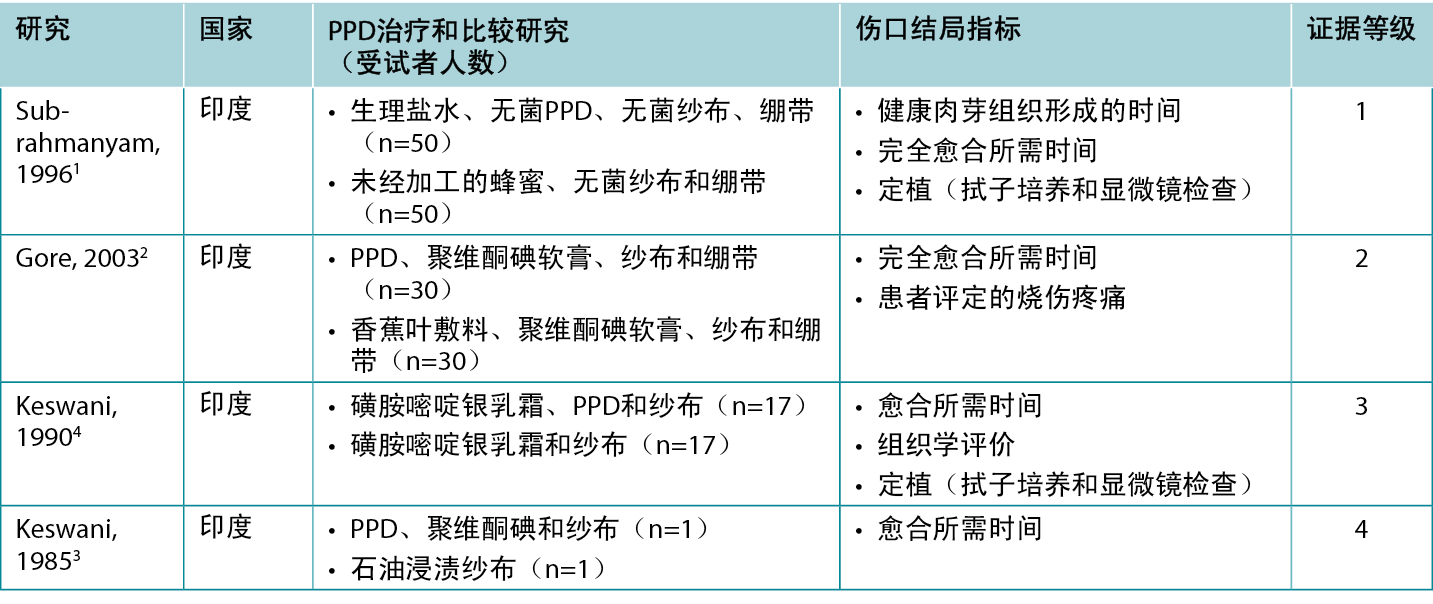Volume 44 Number 3
WHAM evidence summary: potato peel dressing for healing burns
Emily Haesler
Keywords Traditional wound management, evidence summary., potato peel
For referencing Haesler E. WHAM evidence summary: potato peel dressing for healing burns. WCET® Journal 2024;44(3):30-32.
DOI 10.33235/wcet.44.3.30-32
Clinical question
What is the best available evidence for potato peel dressing (PPD) for healing burns?
Summary
PPD is a low cost, traditional dressing used to treat burns and other wounds. Sterile PPD is used with gauze bandages to prevent the burn from desiccation. In most uses, a topical antimicrobial is also applied. Level 1 evidence1 at high risk of bias showed that partial thickness burns treated with PPD can achieve healing, but not as quickly as with honey dressing. Low level evidence2-4 showed no substantial difference in healing time for burns treated with PPD compared to other basic dressings (banana leaf and petroleum-impregnated gauze). In clinical settings without access to modern/advanced wound treatments, PPD could be considered as a protective dressing to use in conjunction with topical antimicrobials for treating burns; however, evaluation of the clinical options is paramount.
Clinical practice recommendations
All recommendations should be applied with consideration to the wound, the person, the health professional and the clinical context.
| There is insufficient evidence to make a recommendation on the use of potato peel dressings to promote healing in burns. |
Sources of evidence: search and appraisal
This summary was conducted using Joanna Briggs Institute5-8 methods. The summary is based on a systematic literature search combining search terms related to PPDs and burns in humans. Searches identified evidence published up to 10 August 2024 in English in the following databases: Cumulative Index to Nursing and Allied Health Literature (CINAHL), Medline (Ovid), Google Scholar, Embase (Ovid), AMED, Health Internetwork Access to Research Initiative (Hinari, via Research4Life) and Cochrane Library. Levels of evidence for intervention studies are reported in Table 1.
Table 1. Levels of evidence for clinical studies

Background
Potato peel dressing is prepared in low and middle resource countries as a cost-effective treatment to protect burn injuries from desiccation in the absence of modern/advanced dressings that promote wound healing.1-4, 9 When the peelings can be sourced at no cost from local food preparation industries the PPD is less expensive than alternatives, including petroleum-impregnated gauze.9
Clinical evidence on potato peel dressing for treating burns
Table 2 summarises studies exploring PPD for treating burns. The evidence comes from the following studies, all of which were at high risk of bias:
- In a small RCT1, partial thickness burns were treated with either sterile PPD covered in sterile gauze and changed on alternate days (n = 50) or unprocessed, undiluted honey dressing changed on alternate days (n = 50). The PPD group achieved granulation tissue in a mean of 9.2 days compared to a mean of 6.8 days in the honey-dressing group. The mean time to total healing was significantly longer in the PPD group (16.2 days versus 9.2 days, p < 0.001) Around 80% of the burns in both groups had colonisation at baseline on culture. By day 7, 90% of burns in the honey group that were colonised at baseline had negative cultures compared with none in the PPD group1 (Level 1).
- In a small comparative study,2 partial thickness burns received either PPD (n = 30) or banana leaf dressing (BLD, n = 30). All burns also received povidone-iodine ointment. Participants acted as their own control with the comparative treatments applied to burns at different anatomical locations. There was no between-group difference for complete healing without a skin graft (PPD = 67% of burns versus BLD = 64% of burns, p > 0.05); most burns completely healed within 10 days. The PPD and BLD were rated equivalently and favourably by participants with respect to managing pain2 (Level 2).
- In an observational study4, (n = 17) PPD was evaluated for partial and full thickness burns using histological examination of wound biopsies. All participants received silver sulphadiazine ointment and the majority of their burn was covered with PPD and gauze. A small burn area was covered with gauze only as a comparison. Complete healing was achieved in 21–26 days; longer healing time was associated with delay in hospitalisation. The PPD was associated with lower levels of inflammation, more orderly cellular stratification and faster epidermal regeneration compared with gauze only, with no difference in microbial profiles4 (Level 3).
- In a case report3, the majority of a child’s partial thickness burn was covered with PPD, and a small area was treated with only petroleum-impregnated gauze. Time to complete healing was faster with PPD (7 days versus 10 days)3 (Level 4).
Table 2. Summary of evidence for potato peel dressing for healing partial and full thickness burns

Considerations for use
- Consider local policies, procedures, and licensing before implementing traditional treatments.
- To prepare PPD, clean boiled potato peelings are adhered to a roller bandage using starch paste before being dried, rolled into a bandage and autoclaved. The bandage is applied with the inner surface of peel in contact with the burn, with no gaps between the peel. This is covered with sterile gauze and a bandage.1, 3, 4
- No allergies or adverse events were experienced in the studies1-4 on PPD for treating burns.
Conflicts of interest
The author declares no conflicts of interest in accordance with International Committee of Medical Journal Editors (ICMJE) standards.
About WHAM evidence summaries
WHAM evidence summaries include the best available evidence to inform clinical practice. The evidence should be evaluated by appropriately trained professionals with expertise in wound prevention and management, and considered in the context of the individual, the professional, the clinical setting and other relevant clinical information. WHAM evidence summaries are developed using methodology consistent with that published by Joanna Briggs Institute5-8. Evidence is identified via a PICO search strategy, assigned a level of evidence and evaluated for risk of bias. Visit the website: www.WHAMwounds.com. Copyright © WHAM Collaborative, Curtin University, and the authors.
WHAM证据总结:土豆皮敷料用于烧伤愈合
Emily Haesler
DOI: 10.33235/wcet.44.3.30-32
临床问题
土豆皮敷料(PPD)用于烧伤愈合的现有最佳证据有哪些?
概述
PPD是一种低成本的传统敷料,可用于治疗烧伤和其他伤口。无菌PPD与纱布绷带一起使用,可预防烧伤部位干燥。在大多数情况下,还会同时使用局部抗菌药物。高偏倚风险的1级证据1表明,使用PPD治疗的二度烧伤可以实现愈合,但不如使用蜂蜜敷料愈合得快。低等级证据2-4表明,与其他基本敷料(香蕉叶和石油浸渍纱布)相比,PPD治疗烧伤的愈合时间没有实质性差异。在没有现代/先进伤口治疗方法的临床环境中,可以考虑将PPD作为一种保护性敷料,与局部抗菌药物一起用于治疗烧伤;不过,对临床方案进行评价至关重要。
临床实践建议
采用任何建议时,应考虑伤口、患者、专业医护人员和临床环境。
| 关于使用土豆皮敷料促进烧伤愈合的建议,目前尚无足够的证据。 |
证据来源检索和评价
本总结采用乔安娜 布里格斯研究所5-8公布的方法进行。本总结以系统性的文献检索为基础,并结合了与人体内PPD和烧伤相关的检索词。在以下数据库中检索了截至2024年8月10日以英文发表的证据:护理与联合卫生文献累积索引(CINAHL)、Medline(Ovid)、谷歌学术、Embase(Ovid)、AMED、健康网络研究计划(Health 卫生互联网共享研究成果倡议(Hinari,通过Research4Life访问)和Cochrane图书馆。表1报告了干预研究的证据等级。
表1.临床研究的证据等级

背景
在缺乏促进伤口愈合的现代/先进敷料的情况下,中低资源国家准备了土豆皮敷料,作为保护烧伤创面不干燥的一种经济有效的治疗方法。1-4, 9当可以从当地的食品加工业免费获得削下的土豆皮时,PPD的成本比其他替代品(包括含石油浸渍纱布)更低。9
土豆皮敷料治疗烧伤的临床证据
表2总结了有关PPD治疗烧伤的研究。证据来源于以下研究,所有研究均存在高偏倚风险:
- 在一项小型RCT1中,对二度烧伤采用无菌纱布覆盖无菌PPD并隔天更换一次(n=50)或未经处理、未稀释的蜂蜜敷料(n=50)进行治疗。PPD 组平均在9.2天内形成肉芽组织,而蜂蜜敷料组平均在6.8天内形成肉芽组织。PPD组达到完全愈合的平均时间明显更长(16.2天 vs. 9.2天,p<0.001)。两组中约80%的烧伤在基线培养时显示有定植。到第7天,蜂蜜敷料组中90%的烧伤(基线时为菌落)培养结果为阴性,而PPD组则没有1(1级)。
- 在一项小型比较研究2中,二度烧伤患者接受了PPD(n=30)或香蕉叶敷料治疗(BLD,n=30)。所有烧伤部位均涂抹了聚维酮碘软膏。受试者作为自己的对照,对不同解剖位置的烧伤进行对比治疗。在没有植皮的情况下,组间的完全愈合率没有差异(PPD=67%烧伤 vs. BLD=64%烧伤,p>0.05);大多数烧伤在10天内完全愈合。受试者对PPD和BLD在控制疼痛方面的评价相当,并给予好评2(2级)。
- 在一项观察性研究4中,通过对伤口活组织切片进行组织学检查,评价了PPD用于二度和三度烧伤的效果(n=17)。所有受试者都涂抹了磺胺嘧啶银软膏,大部分烧伤部位都覆盖了PPD和纱布。仅用纱布覆盖一小块烧伤区域作为对比。完全愈合需要21-26天;愈合时间越长,住院时间越长。与仅使用纱布相比,PPD的炎症程度更低,细胞分层更有序,表皮再生速度更快,但微生物特征无差异4(3级)。
- 在一份病例报告3中,一例儿童的大部分二度烧伤被PPD覆盖,一小部分仅用石油浸渍纱布处理。PPD的完全愈合时间更快(7天 vs. 10天)3(4级)。
表2.土豆皮敷料用于二度和三度烧伤愈合的证据总结

使用注意事项
- 进行传统治疗前,考虑当地政策、程序和许可情况。
- 在制备PPD时,先用淀粉糊将煮熟的干净土豆皮粘在滚筒绷带上,然后晾干,卷成绷带并进行高压灭菌。使用绷带时,土豆皮的内表面与烧伤接触,土豆皮之间不能有间隙。使用消毒纱布和绷带覆盖。1, 3, 4
- 在PPD治疗烧伤的研究中,没有出现过敏或不良事件1-4。
利益冲突
根据国际医学期刊编辑委员会(ICMJE)的标准,作者声明无利益冲突。
关于WHAM证据总结
WHAM证据总结包含了可用于指导临床实践的最佳证据。证据应由经过适当培训的具有伤口预防和管理专业知识的专业人士进行评价,并应根据个人、专业人士、临床环境以及其他相关临床信息进行考虑。WHAM证据总结的编制方法与乔安娜·布里格斯研究所公布的方法一致5-8。通过PICO检索策略识别证据,划分证据等级并评价偏倚风险。访问网站:www.WHAMwounds.com。版权所有˝ 科廷大学WHAM协作组织以及相关作者。
Author(s)
Emily Haesler
PhD P Grad Dip Adv Nurs (Gerontics) BN FWA
Adjunct Professor, Curtin University, Curtin Health Innovation Research Institute,
Wound Healing and Management (WHAM) Collaborative
References
- Subrahmanyam M. Honey dressing versus boiled potato peel in the treatment of burns: A prospective randomized study. Burns, 1996; 22(6): 491-3.
- Gore M, Akolekar D. Evaluation of banana leaf dressing for partial thickness burn wounds. Burns, 2003; 29(5): 487-92.
- Keswani M, Patil A. The boiled potato peel as a burn wound dressing: a preliminary report. Burns Incl Therm Inj, 1985; 11(3): 220-4.
- Keswani M, Vartak A, Patil A, Davies J. Histological and bacteriological studies of burn wounds treated with boiled potato peel dressings. Burns, 1990;16(2):137-43.
- Aromataris E, Munn Z, editors. (2020) JBI Manual for Evidence Synthesis. Joanna Briggs Institute.
- Joanna Briggs Institute Levels of Evidence and Grades of Recommendation Working Party (2013). New JBI Grades of Recommendation. Adelaide, Australia: Joanna Briggs Institute.
- Joanna Briggs Institute Levels of Evidence and Grades of Recommendation Working Party. (2014) Supporting Document for the Joanna Briggs Institute Levels of Evidence and Grades of Recommendation. Adelaide, Australia: Joanna Briggs Institute.
- Munn Z, Lockwood C, Moola S. The development and use of evidence summaries for point of care information systems: A streamlined rapid review approach. Worldviews Evid Based Nurs, 2015;12(3):131-8.
- Patil A, Keswani M. Bandages of boiled potato peels. Burns Incl Therm Inj, 1985;11(6):444-5.



